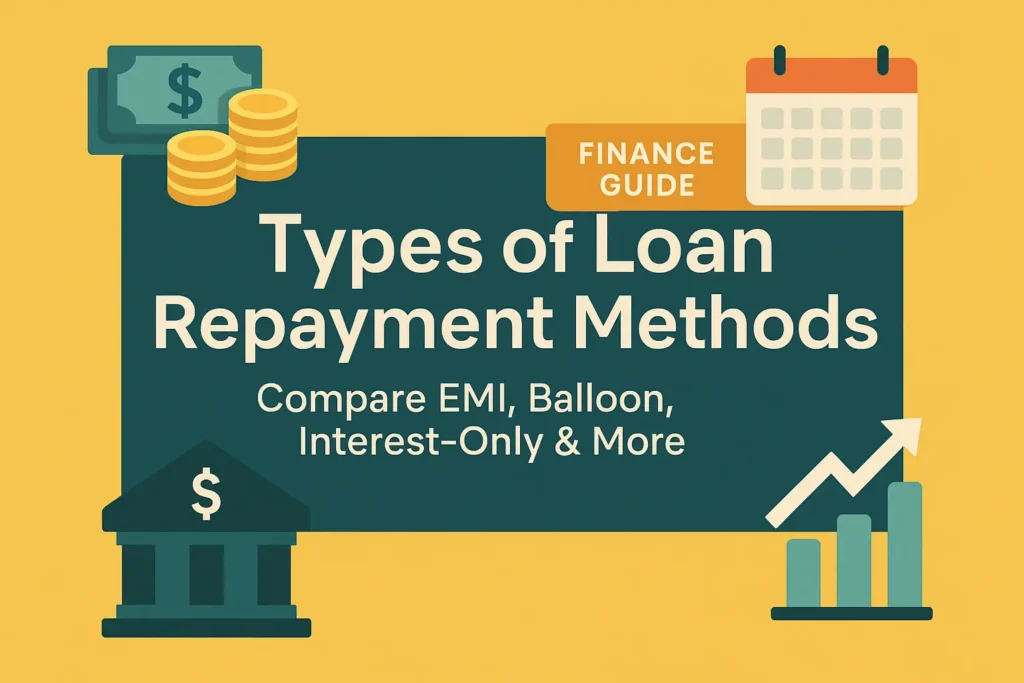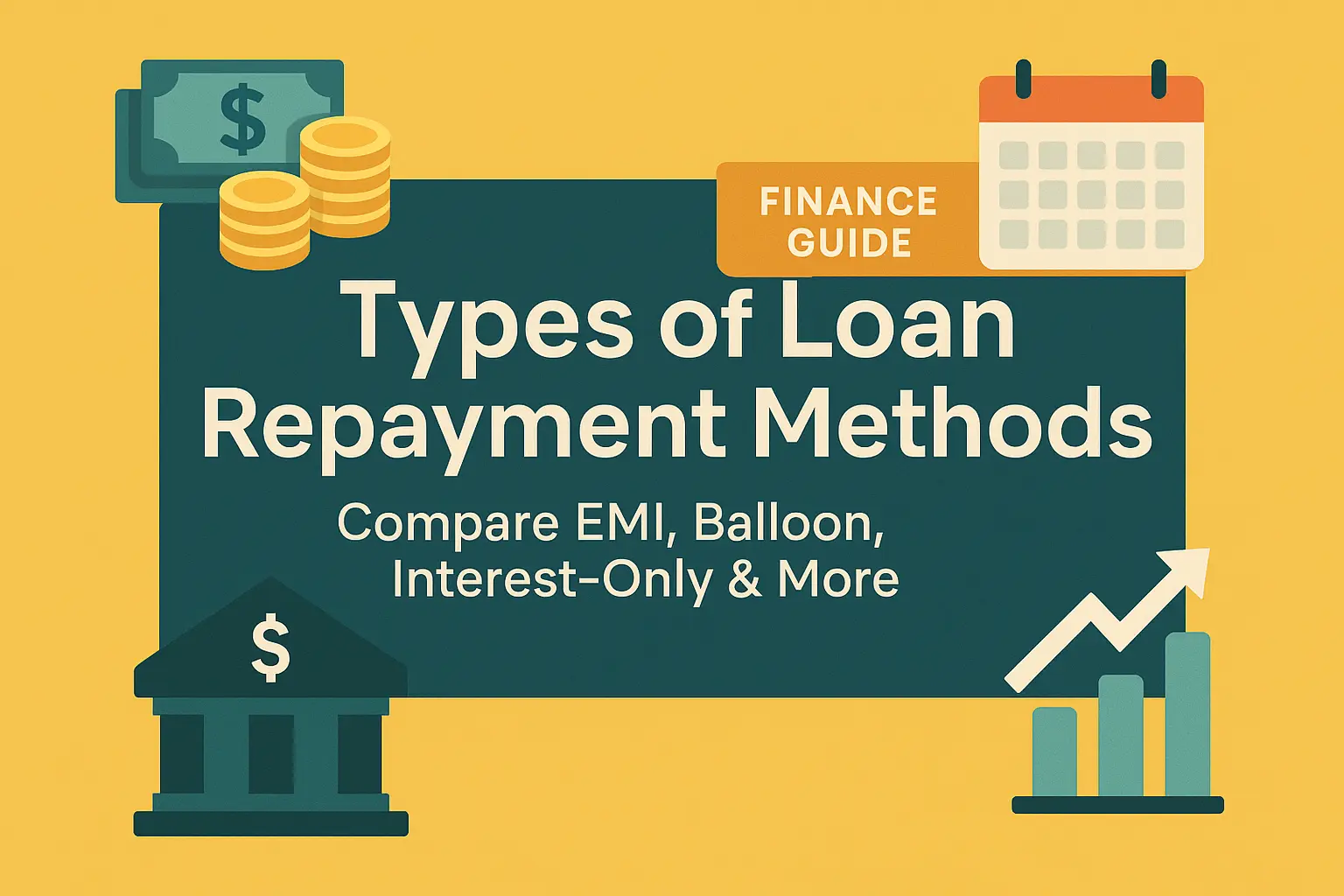Table of Contents

📊 Loan Repayment Methods at a Glance
💼 EMI (Equated Monthly Installment)
- Fixed monthly payments
- Includes interest + principal
- Best for home, auto, personal loans
💣 Bullet Repayment
- Interest-only during tenure
- Full principal at the end
- Ideal for short-term business loans
🎈 Balloon Payment
- Small payments early
- Big payment at the end
- Used in auto & property loans
📈 Graduated/Step-Up
- Payments increase over time
- Fits growing income
- Good for early career borrowers
📉 Step-Down Repayment
- High EMI at start, reduces later
- Suits retirees & early payers
💸 Interest-Only Repayment
- Only pay interest first
- Principal paid later
- Popular in property investment
✅ Choose a repayment method that fits your income & goals!
Introduction
When it comes to borrowing money—whether it’s a mortgage, student loan, auto loan, or personal loan—the repayment method plays a crucial role in how you manage your finances.
Choosing the right loan repayment method can impact how much interest you pay, your monthly budget, and even your long-term financial stability. In this guide, we’ll explore the most common types of loan repayment methods used across the USA, UK, and other Tier 1 countries.
Why Loan Repayment Methods Matter
Before you pick a loan, it’s essential to understand how repayment works. The structure of your repayment schedule affects:
- Your monthly payments
- The total interest you pay over time
- Your financial flexibility
- Your ability to pay off debt early
Whether you’re a first-time borrower or refinancing an existing loan, knowing your repayment options helps you make better decisions.
1. Equated Monthly Installment (EMI)
Common in: India, Asia, and now globally
Best for: Personal loans, home loans, auto loans
With EMI, you repay your loan through fixed monthly payments that include both principal and interest. Over time, the interest portion reduces, while the principal increases.
Pros:
- Predictable monthly payments
- Easy to budget
- Simplifies repayment
Cons:
- Less flexibility
- Higher total interest if the loan term is long
2. Bullet Repayment
Common in: Corporate loans, short-term lending
Best for: Bonds, agricultural loans, certain business loans
In a bullet repayment plan, you only pay interest periodically, while the entire principal is repaid at the end of the loan term.
Pros:
- Lower financial burden during tenure
- Great for short-term or seasonal income earners
Cons:
- Requires lump sum at the end
- Risky if cash flow isn’t managed
3. Balloon Payment
Common in: Auto loans, commercial property loans
How it works: You pay small installments, and then a large “balloon” payment at the end.
Pros:
- Lower payments in the beginning
- Useful for people expecting a future cash windfall
Cons:
- Final payment is large and risky
- Not suitable for unstable incomes
4. Graduated Payment Loan
Common in: U.S. Federal student loans
How it works: Payments start low and gradually increase over time, assuming your income will grow.
Pros:
- Affordable initially
- Good for early-career professionals
Cons:
- Higher total interest
- Risky if income growth doesn’t happen
5. Step-Up Repayment Plan
How it works:
You start with lower EMIs that increase every year. Perfect for those whose income is likely to rise (e.g., salaried professionals).
Pros:
- Low starting EMI
- Matches income growth
- Higher loan eligibility
Cons:
- Payments rise quickly
- Requires good income projection
6. Step-Down Repayment Plan
How it works:
You pay a higher EMI at the beginning, which reduces over time. Ideal for people nearing retirement or expecting lower income later.
Pros:
- Fast principal repayment
- Lowers total interest
Cons:
- High initial burden
- Not suitable for tight budgets
7. Interest-Only Repayment
Common in: UK & Australian mortgages, U.S. investment properties
How it works: You pay only the interest for the initial period (e.g., 3–5 years), and start principal repayments later.
Pros:
- Low initial payments
- Great for investors
Cons:
- No equity buildup during interest-only period
- Risk of payment shock when principal begins
8. Reducing Balance Method
How it works: Interest is charged only on the outstanding principal, so as you repay, your interest reduces over time.
Pros:
- Transparent interest calculation
- Lower total interest compared to flat-rate
Cons:
- EMI varies (unless locked in as part of EMI structure)
9. Fixed Principal Repayment
How it works:
The principal is divided equally over the loan term. Interest is calculated on the remaining amount, so EMIs reduce over time.
Pros:
- Reduces burden gradually
- Transparent and structured
Cons:
- High initial EMI
- Not suitable for borrowers with tight starting budgets
10. Prepayment or Partial Prepayment
How it works:
You pay an extra amount (partial or full) before the loan term ends.
Pros:
- Reduces total interest
- Frees you from debt early
Cons:
- May incur prepayment penalties (check with your lender)
- Requires excess funds
Comparison Table of Loan Repayment Methods
| Repayment Method | Flexibility | Initial Payment | Risk Level | Best For |
|---|---|---|---|---|
| EMI | Medium | Moderate | Low | Salaried, Home/Auto Loans |
| Bullet Repayment | Low | Low | High | Business, Seasonal Earners |
| Balloon Payment | Medium | Low | High | Auto Loans, Real Estate |
| Graduated Payment | High | Low | Medium | Students, New Professionals |
| Step-Up Repayment | Medium | Low | Medium | Fast-Rising Careers |
| Step-Down Repayment | Medium | High | Low | Retirees, Early Repayers |
| Interest-Only Repayment | High | Very Low | High | Investors, Property Buyers |
| Reducing Balance | Medium | Moderate | Low | Common Worldwide |
| Fixed Principal Repayment | Low | High | Low | Project Finance, Business Loans |
FAQs: People Also Ask
What are the most common loan repayment methods?
The most common methods are EMI, interest-only repayment, and balloon payments, depending on the type of loan and region.
Which repayment method is best for home loans?
For most people, EMI with a reducing balance method is best for home loans due to predictability and cost-efficiency.
What is a balloon payment?
A balloon payment is a large one-time payment due at the end of a loan term, following smaller monthly payments.
Can I switch loan repayment methods later?
It depends on your lender and loan agreement. Some allow switching (e.g., from interest-only to EMI), but may charge a fee.
Is interest-only repayment a good idea?
It can be, especially for investors or short-term borrowers, but comes with higher long-term risk due to delayed principal payment.
Conclusion: Choose Smart, Borrow Smarter
Loan repayment isn’t one-size-fits-all. The best repayment method depends on:
- Your income pattern
- Loan amount and purpose
- Future financial goals
Whether you’re a first-time homebuyer in the U.S. or a professional in the UK refinancing a personal loan, understanding these loan repayment methods helps you plan better, save more, and stay stress-free.
👉 Tip: Always compare options using a loan calculator and consult with your bank or financial advisor before committing.
Internal Linking Suggestions
- Want to boost your credit score? Read our Ultimate Credit Card Guide
- Confused between fixed vs variable rates? Check our Loan Interest Guide
If you’d like a downloadable PDF comparison chart or help choosing a loan plan, drop your email below for expert insights!


1 thought on “Types of Loan Repayment Methods: A Complete Guide to Manage Your Debt Smartly”